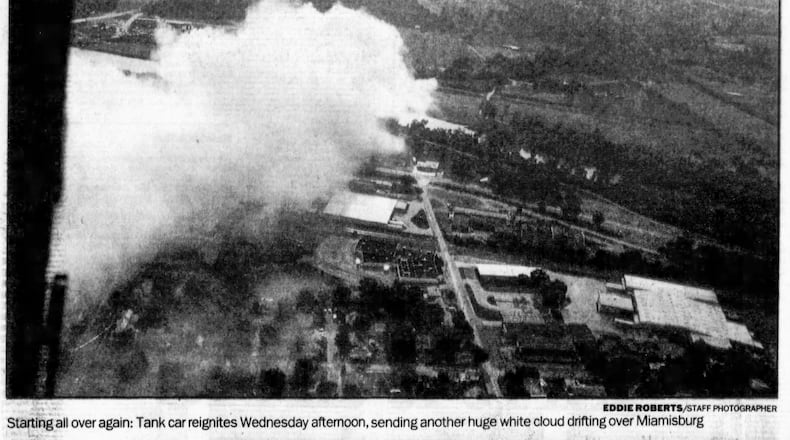» PHOTOS: Scenes from the 1986 Miamisburg train derailment and 5-day fire
What caused the crash?
The train was traveling at 44 mph, one mile per hour slower than the posted limit of 45 mph. along a stretch of straight track.
“Mechanical failure” was the initial reason given by investigators.
Later in the week, the Federal Railroad Administration said that high temperatures caused the tracks, which were new and recently installed, to separate, which led to the derailment. It was determined that temperatures reaching into the 90s caused the tracks to widen 5 inches over a 35-foot stretch.
Credit: Charles Steinbrunner
Credit: Charles Steinbrunner
What is white phosphorus?
White phosphorus is a refined form of the element phosphorus. It’s most commonly used in agricultural fertilizer and in rodent and insect poisons. It is also used in the manufacture of fireworks and matches.
According to the Centers for Disease Control and Prevention, “White phosphorus burns in air and causes severe burns upon contact with skin or eyes. White phosphorus smoke will also cause eye and respiratory tract irritation. Other initial adverse health effects are primarily due to gastrointestinal irritation.”
White phosphorus can be used in military bomb-making, but air-dropping phosphorus in areas where it can endanger civilians has been banned by the United Nations. Because it burns bright and fast, it continues to be used by militaries worldwide to illuminate targets or create smokescreens.
The phosphorus on this train was on it’s way to an industrial chemical processing company at Fernald, near Cincinnati, to be converted to phosphoric acid, which has hundreds of industrial applications.
How long did it burn?
White phosphorus fires are extremely difficult to put out. The chemical ignites instantly when mixed with oxygen. It is usually stored under water to protect it from combustion.
Firefighters worked around the clock for five days to extinguish the flames.
Firefighters, who conferred with the special hazardous materials unit of the Dayton Fire Department, decided on a tactic of trying to cool and drown the blaze with enormous quantities of water.
Along with the Dayton Fire Department, fire crews from Miamisburg and Miami and Washington townships were fighting the fire in alternating teams of 15 firefighters each.
Firefighters had to alternate because their eyes became irritated if they stayed near the fire too long.
There were two holes in the railcar, spilling 12,000 gallons of phosphorus. At times, flames reached 40 feet and clouds of smoke stretched as far a 13 miles away, reaching beyond East Dayton and Mad River Twp.
The first day, an estimated 3,000 gallons of water a minute were put to the flames. It took about four hours to bring the inferno under control, although not extinguished.
The next day, the fire erupted a second time after the tanker shifted and tipped over. It was decided at that time that letting the fire burn out on its own was the best choice. By this time, phosphorus that had leaked into Bear Creek was also burning.
At the same time, fires were burning in other cars involved in the derailment.
What was in the other derailed railcars?
The train also had cars filled with cargo including animal fat, sulphur, newsprint, lumber and automobile parts.. The animal fat occasionally caught fire and some spilled into the nearby Bear Creek.
Were there any injuries?
On the first day, area hospitals examined 166 people for complaints of skin, eye and lung irritation.
After two days, over 300 people had been treated in seven area hospitals.
After seven days health officials estimated that 400 people were treated for ailments that could have been related to the fumes. They also said that people who were exposed to the fumes should suffer no long-term effects but those who received treatment would be monitored.
About the Author




